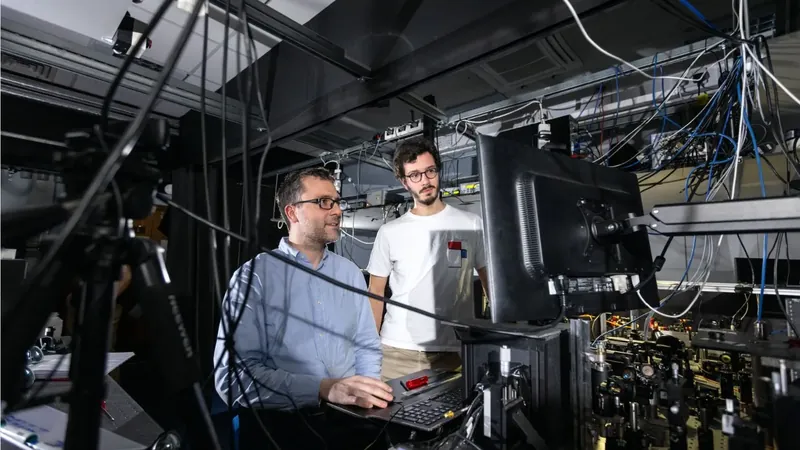
Revolutionizing Quantum Physics: Physicists Manipulate Light Across Time and Space
2025-05-23
Author: Charlotte
A Quantum Leap Forward
In a groundbreaking achievement, a team of physicists at Imperial College London has taken one of the most famous experiments in science and turned it on its head—by delving into the realm of time. Their innovative approach to the double-slit experiment heralds a new era in quantum physics.
Changing Light in an Instant
Led by Professor Riccardo Sapienza, the researchers examined how light interacts with a specially designed material that can alter its optical properties in a staggering few femtoseconds—one quadrillionth of a second. This rapid change allows them to literally catch light in the act as it shifts.
From Wave to Time-Based Patterns
Traditionally, the double-slit experiment, first conducted by Thomas Young in 1801, demonstrated light's wave-like behavior by producing interference patterns. This latest iteration, however, eliminates the slits entirely, using lasers to modify light frequencies through a thin film of indium-tin-oxide, commonly found in smartphone screens. The results? New temporal patterns rather than spatial ones, showcasing how light frequencies overlap and interact.
Unlocking New Scientific Frontiers
Published in Nature Physics, this research not only enhances our grasp of light's fundamental nature but also paves the way for innovative materials capable of precise light control in both space and time. "This work serves as a stepping-stone for creating advanced materials that can dramatically influence technology," says Sapienza.
Spectroscopy Redefined
An exciting outcome of this study is the potential for revolutionary forms of spectroscopy. This could allow scientists to analyze the structure of light pulses with unprecedented clarity, revealing details that were previously out of reach. Professor Sir John Pendry, a co-author of the study, declared, "The double time slits experiment opens the door to a new realm of spectroscopy, achieving resolutions down to a single wave cycle."
Transforming Telecommunications and Beyond
The practical implications of this research are staggering. Enhanced control over light timing and frequency could revolutionize telecommunications, leading to faster and more reliable data transfer. Imagine communication networks operating at new heights of speed and efficiency, transforming our online experiences.
The Future of Computing
In the realm of computing, the advent of metamaterials that manipulate light could give rise to optical processors that outpace traditional electronic circuitry in speed and energy efficiency. Optical computing, which has long been the elusive goal of scientists, promises to dramatically enhance data processing capabilities while reducing energy usage.
Medical Marvels on the Horizon
In healthcare, the ability to finely control light may lead to advanced imaging solutions and potentially revolutionary treatment methods, allowing for earlier disease detection and targeted therapies that minimize damage to healthy tissues.
Pioneering New Technologies
This experiment also sets the stage for investigating "time crystals," which possess repeating structures not limited to space but extending into time. According to co-author Professor Stefan Maier, these materials could lead to breakthroughs in ultra-fast optical switching technology.
Broader Implications Across Industries
The findings promise significant implications not only in telecommunications, computing, and medicine but also across sectors like energy, aerospace, and defense. Precise light control has the potential to improve energy systems and develop advanced sensing technologies.
A New Era in Light Manipulation
As this remarkable research unfolds, the role of metamaterials and quantum physics will undoubtedly become more pivotal. Mastering light manipulation in both space and time can revolutionize our interactions with technology, ushering in faster, more effective tools.
The Journey Has Just Begun
Professor Sapienza emphasizes the significance of their findings: "This experiment is just the beginning. With continued research, we could discover entirely new ways to understand and control light, fostering innovations that could reshape everything from our smartphones to medical practices."









 Brasil (PT)
Brasil (PT)
 Canada (EN)
Canada (EN)
 Chile (ES)
Chile (ES)
 Česko (CS)
Česko (CS)
 대한민국 (KO)
대한민국 (KO)
 España (ES)
España (ES)
 France (FR)
France (FR)
 Hong Kong (EN)
Hong Kong (EN)
 Italia (IT)
Italia (IT)
 日本 (JA)
日本 (JA)
 Magyarország (HU)
Magyarország (HU)
 Norge (NO)
Norge (NO)
 Polska (PL)
Polska (PL)
 Schweiz (DE)
Schweiz (DE)
 Singapore (EN)
Singapore (EN)
 Sverige (SV)
Sverige (SV)
 Suomi (FI)
Suomi (FI)
 Türkiye (TR)
Türkiye (TR)
 الإمارات العربية المتحدة (AR)
الإمارات العربية المتحدة (AR)